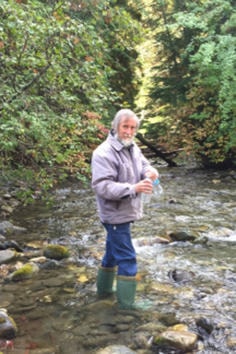When Kevin Schiller was a boy, he remembers a very different Arrow Lakes ecosystem.
“There was deer everywhere here in our valley, on our roads, and the rivers used to be boiling with fish,” he recalls. “It’s all changed now. You don’t see the bull trout run, the deer population is down quite a bit.”
Schiller, the new president of the Arrow Lakes Environmental Stewardship Society, is helping spearhead an initiative to try to restore at least some of that lost biodiversity.
“We’re definitely hoping we can get the interest of the community behind us,” he said. “The people we’ve been talking to, the response is huge, just about everyone we talk to in the public are just loving the idea.”
The idea is to set up a “Watershed Planning Team” of stakeholders and interested parties, to start taking action- big steps and small- to try to restore the Arrow Lakes ecosystem. ALESS has already held talks with some individuals and groups, and next week will hold a public meeting to launch the project in earnest.
Schiller says the idea of the planning team is pretty easy to understand.
“Those that benefit from the environment should support a stable approach to restoring it,” he said.
“I believe everybody recognizes the need for restoration,” he added. “So many people are telling me it’s time for someone to step up to the plate and do more.”
It’s a model that has worked well in the Salmo area, where the Salmo Watershed Streamkeeper’s Society has gathered diverse interest groups and stakeholders, from BC Timber Sales to local trappers, in a collaborative group to try to protect and enhance local rivers and streams.
“This is not an airy-fairy, willy-nilly approach,” says Gerry Nellestijn, who’ll be at the January 25th meeting in Nakusp to describe the Salmo experience. “… [I]t is a transition philosophy. Many of the stakeholders are not really experienced in working collaboratively, and it refocuses their energy.”
Working with groups that might have very different, and contradictory, needs and interests can be a challenge. But Nellestijn says the planning team model allows those different interests to find something they can do in their own particular area of expertise, and contribute to the bigger picture of restoring the environment.
“…[P]eople are seeing that they have to participate in making a difference in their environment these days,” he says. “The challenge is to overcome the old impetus out there, to get to how can we make a better place and not lose our own interest.”
Because it’s a community based, non-government model, the emphasis has to be on collaboration and cooperation, he notes.
“The truth of the matter is, it’s totally voluntary. There’s nothing regulatory about this,” he told Arrow Lakes News. “This is a ‘should’ based approach. I think people are there.”
“I feel here it’s been relatively successful in terms of having participation from a broad base of groups and businesses and individuals. But if you’re not there, there’s no way we can drag you into it.”
In late January, Schiller and Nellestijn will make their pitch for setting up a planning team for the Arrow Lakes. They’ll meet with stakeholders in the morning, and a public information meeting will gauge general interest in the afternoon.
Schiller says if the support is there to set up a steering committee, they’ll first focus on restoring a single watershed somewhere in the southern half of the lakes, from Galena Bay to Castlegar. Which watershed will be decided by the steering committee.
Nellestijn says he’s confident the model will work for Nakusp.
“The Arrow Lakes need it. I am sure that people around the Arrow know that. It’s been heavily impacted by the hydro activity, and it doesn’t have to be. We can do things differently without impacting the bottom line aggressively.
“Three or four dedicated people can make a real difference in an approach like this.”
The public meeting is January 25th at 4 p.m. at the Senior’s Hall (Log Building) in Nakusp.
